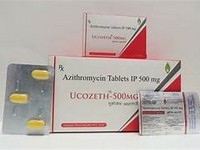Azithromycin
CLINICAL USE
Antibacterial agent
DOSE IN NORMAL RENAL FUNCTION
PHARMACOKINETICS
DOSE IN RENAL IMPAIRMENT
GFR (mL/MIN)
DOSE IN PATIENTS UNDERGOING RENAL REPLACEMENT THERAPIES
IMPORTANT DRUG INTERACTIONS
Potentially hazardous interactions with other drugs
ADMINISTRATION
Reconstition
Powder for oral suspension to be reconstituted with water (200 mg/5 mL strength)
Route
Oral
Rate of Administration
–
Comments
Administer as a once daily dose 1 hour before food or 2 hours after food.
